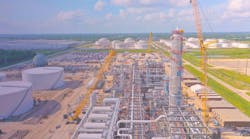Moving large process-plant pressure vessels usually requires special handling facilities because of both the size and weight of the vessels. The extreme weight of many process vessels must be dispersed to avoid damage to docks, roadways, and ground surfaces.
Two vessel moves have demonstrated how a temporary mat system can be used to provide an adequate loadbearing surface for moving a vessel from fabricating facilities to final plant site.
Davenport/Mammoet, a heavy equipment transportation company in Rosharon, Tex., used a temporary mat system made by Uni-Mat International, Houston, to disperse the weight of a 150,000-ton recycle column for Huntsman Chemical Co., Corpus Christi, Tex.
The mat system consists of 8 ft x 14 ft interlocking mats of oak beams. Mats covered a 40 ft x 42 ft dock area for vessel unloading, and a 308 ft long roadway to transport the vessel to the plant access road (Fig. 1).
The mats spread the normal concentrated load of the multi-tired transporter vehicle of 120 psi per transporter tire to 5 psi at the existing grade (Fig. 2). Mats were also used to level low spots between the dock and plant access road.
Installation of the mats, covering a 7,280 sq ft area, took 4 hr, using one forklift truck and two workmen. Removing the mat system also took 4 hr.
Davenport/Mammoet also used the Uni-Mat system to provide decking on a barge to transport a 630-ton pressure vessel from a heavy-lift ship to an ethylene plant in Sulfur, La. (Fig. 3). The barge was needed because the ship could not negotiate the channel to the plant site.
The deck space was about 40 ft wide x 180 ft long, and had to be covered to reduce concentrated loads on the steel deck. The total load on the barge included the vessel plus a 200 ton multi-tired transporter. Concentrated loads were reduced by 75% by using the mats.
Mats were also used to cross underground pipelines. The mats service all construction traffic into the plant, and they can handle loads up to 825,000 lb.
Copyright 1990 Oil & Gas Journal. All Rights Reserved.
